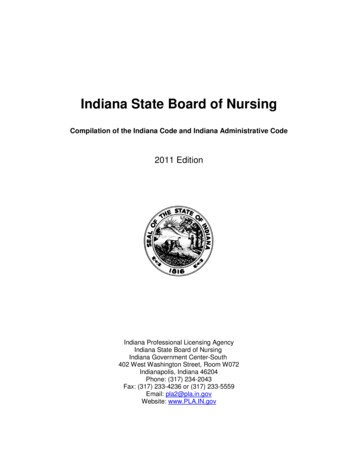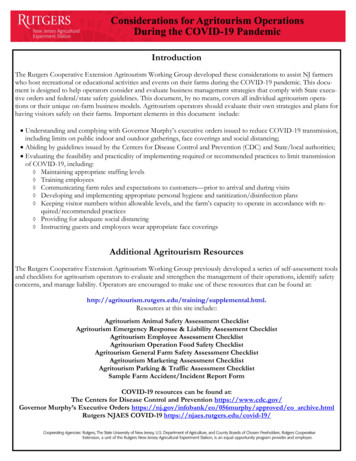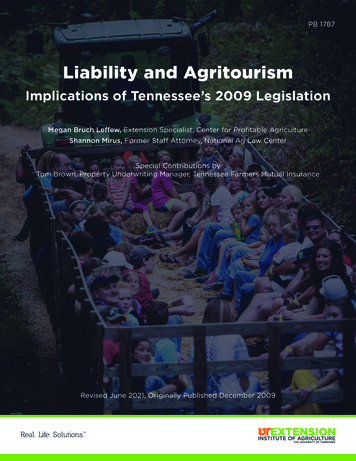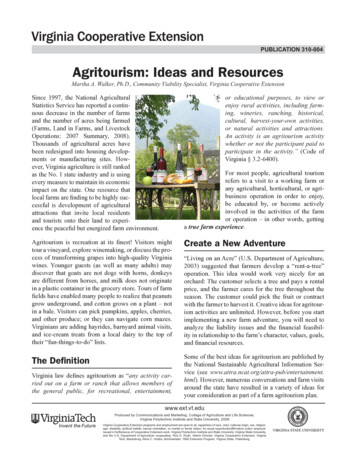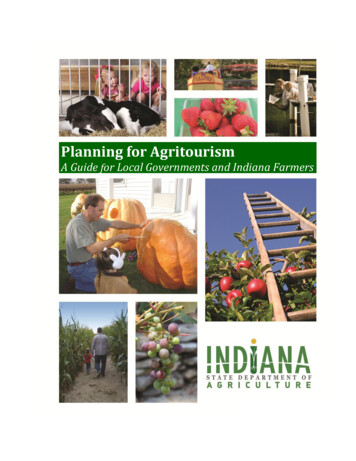
Transcription
Planning for AgritourismA Guide for Local Governments and Indiana Farmers0
For more information:Indiana State Department of AgricultureOne North Capitol Avenue, Suite 600, Indianapolis, Indiana 46204T 317.232.8770 F 317.232.1362 www.in.gov/isda
Introduction and OverviewAgritourism is a business model that is growing in popularity as Indiana farmers recognize a need todiversify their operations and supplement their farm incomes. In addition, there is a growing publicdesire to engage in rural experiences and outdoor recreational activities. By combining agriculture andtourism, agritourism offers rural experiences to urban residents and economic diversification to farmers.Planning for agritourism requires a forward-thinking, locally-driven process. Planners must acknowledgeagriculture as a land use and a business. The Indiana Land Resource Council (ILRC) designed thisplanning guide for agritourism providers, community leaders, extension agents, and rural economicdevelopment and tourism professionals.What is agritourism?There is no universal definition of agritourism.11 It is generally understood to be a business model thatlinks agricultural production/processing with tourism in order to attract visitors onto a farm, forest, orother agricultural business for the purposes of entertaining and/or educating the visitors and generatingincome for the farm, forest, or business owner. Purdue University defines agritourism as “any businessconducted by a farmer or processor for the enjoyment or education of the public, to promote theproducts of the farm and to generate additional farm income.” (Purdue University, 2005) Incomparison, Lancaster County Pennsylvania defines agritourism as “visiting a working farm or anyagricultural, horticultural or agri-business operation for the purpose of enjoyment, education or activeparticipation and involvement in the activities of the farm or enterprise.” (Lancaster County PlanningCommission, 2009)In 2011, the Indiana General Assembly defined an agritourism activity as: (1) an activityat an agricultural, horticultural, or agribusiness operation where the general public isallowed or invited to participate in, view, or enjoy the activities for recreational,entertainment, or educational purposes, including farming, ranching, historic andcultural agricultural activities, self-pick farms, or farmers' markets; (2) an activityinvolving an animal exhibition at an agricultural fair; or (3) natural resource basedactivities and attractions, including hunting, fishing, hiking, and trail riding.Examples of AgritourismIndiana is home to a wide variety of agritourism operations. Common examples include: 1pumpkin picking patches;corn mazes/crop art;educational and demonstrative tours;walking and bicycling tours and trails;U-Pick operations;petting and feeding zoos;hay rides;cut-your-own Christmas tree farms;agricultural museums;living history farms;processing demonstrations;on-farm farmers' markets and roadside stands;The term "agritourism" is often used interchangeably with "agri-tourism," "agrotourism," "farm tourism," "agricultural tourism," or "agritainment."2
winery tours and wine tasting;ice cream/bakery facilities;outdoor recreation (fishing/hunting/bird watching/natural features);horseback riding;rural bed & breakfasts;consuming agricultural or food products;garden tours; andother commercial activities in conjunction with farm, forest or agribusiness use.For more information on Indiana agritourism experiences, please see the IndianaAgritourism and Farmers’ Market Online Director . The Indiana State Department ofAgriculture (ISDA), in partnership with the Indiana Office of Tourism Development,created the Directory to help Hoosiers and visitors find agritourism destinations andlocally-grown food across the state.Importance of AgritourismAgritourism provides a number of economic, educational, and social benefits to producers,consumers/tourists, and communities. Furthermore, agritourism provides incentives for producers toremain in agriculture.The agriculture industry is facing a growing number of challenges, such as market competition, risingland and input costs, encroachment from sprawl, and a complex regulatory environment. In order tostay in business, some operations have had to look for ways to add value to their products and createdependable revenue sources. Because of their proximity to a number of large and diverse metropolitanareas of the Midwest Indiana farmers have tremendous opportunity to diversify their list of product andservice offerings and supplement farm incomes.Agritourism enterprises provide numerous economic benefits to the surrounding community.Operations create jobs and support the local economy through their purchases of goods and services.Other “spillover” economic development opportunities occur when agricultural tourists shop, eat andlodge in the surrounding community. Agritourism also provides rural communities with the potential toincrease their local tax bases because farmland and forestland generally require fewer communityservices and generate more local tax revenue than they cost in services.2 More importantly, agritourismoperations are unique, local businesses, which cannot later be “outsourced” to other communities.Lancaster County Pennsylvania is nationally recognized for its agritourism enterprises.In 2009, the local plan commission and tourism development council developed acomprehensive plan and agritourism guidelines to maximize their economicdevelopment opportunities. The publication identified several benefits that could bedirectly attributed to the development of a successfully managed and regulatedagritourism program. These benefits include: Enhancing the economic viability of the farm and providing on-site employmentopportunities Generating additional income or off season income for the farmer Interacting and educating locals and visitors about the importance of farming inLancaster County Increasing awareness of local agricultural products Developing a new consumer market nicheIn 2010, the ILRC sponsored Dr. Larry DeBoer’s “A Cost of Community Services Study for Indiana Counties and School Corporations. A copy ofthe study and the council’s recommendations for its use can be found at http://www.in.gov/isda/2357.htm.23
Agritourism provides educational experiences that connect visitors to scenic landscapes and the localcommunity heritage. Such operations can also be used to educate the public about the industry’scontribution to the local quality of life. For example, agritourism can provide sustainable ways to carefor rural working lands and scenic areas. Agritourism can also preserve the agricultural heritage of acommunity.Farmland and forestland preservation ensures that future generations will have theopportunity to visit local farms and timber operations, learn more about agriculture, participate inrecreational activities and enjoy a local food supply. In short, agritourism has the potential to turnurban residents into strong allies for farms, forests and other agricultural enterprises.In order to promote agritourism enterprises in Indiana, the General Assembly enacted a limitation ofliability for agritourism providers who provide a statutory warning to participants and meet otherspecific requirements. Essentially, the law limits liability which may arise from the "inherent risks ofagritourism activities." Inherent risks are defined as "those conditions, dangers, or hazards that are anintegral part of an agritourism activity." Ind. Code Section 34-31-9-4. If all of the statutory requirementsare met, then a participant or his/her representative cannot make a claim for injury, loss, damage ordeath, caused by the inherent risks of an agritourism activity. There are some exceptions andexclusions. For instance, this law does not limit liability for injuries caused by improperly trainedemployees or due to a known dangerous condition on the land which is unknown by the participant.Potential ObstaclesAlthough it is very likely that agritourism development can be successfully integrated into localcommunities without great disruption, there are some potential challenges. Planning for agritourismrequires attention to possible neighborhood impacts and competing interests within the agriculturalcommunity.Residents often have concerns about the potential noise, traffic, and trespassers because these impactshave the potential to change the overall character of the community. When farmers take proactiveactions to maintain good relationships with neighboring land owners, local decision makers and thecommunity many of these concerns can be resolved informally. There are also several tools availablethat can be used to minimize potential obstacles.Noise levels can potentially diminish the quality of life for neighboring land owners. In general, thenoise level in rural and agricultural areas is lower than urban areas. These peaceful surroundings are apart of the character of rural areas. However, agricultural operations can also be very noisy. Machinery,equipment, trucks and animals produce various noises. When considering approval of an agritourismoperation local decision makers should determine whether the noise of the agritourism operation issimilar or different from the noise that normally occurs in rural and agricultural areas. If the noise is nottypical to the surrounding area, local decision makers should consider whether the activity will be daily,seasonal or event-based. Noise concerns can be addressed through buffers or noise ordinances. Thenoise ordinances should not be more restrictive for agritourism operations than for other businesses.Increased traffic can also be a concern for neighboring land owners. Local governments could utilize atraffic management plan that identifies the projected number of vehicles and any anticipated use ofpublic roads to determine potential traffic impacts. To minimize additional traffic hazards, agritourismoperations need to provide adequate off-street parking.Trespassing is a concern for both agritourism providers and neighboring land owners. Operators shouldregularly check restricted areas for trespassers. If trespassers are found, such persons need to beescorted back to the proper locations. To limit trespassing onto neighboring landowners, agritourismproviders could post “no trespassing” signs at property boundaries. Posting such signs demonstrates a4
reasonable and prudent effort to protect neighboring landowners from increased liability.Local decision makers must also recognize differing perspectives and competing interests within theagricultural community. While some farmers feel that planning is an opportunity to influence the futureof the community, others feel anger and uncertainty towards the planning process. In addition, farmershave multiple interests in their property that can conflict with each other. As simultaneous landowners,business owners, taxpayers and community members, a farmer’s interest may vary depending on theissue. For example, a farmer who is actively transitioning operations to a younger generation maysupport policies that limit non-agricultural development. On the other hand, farmers who plan to exitthe industry in the near future may be more likely to emphasize their interest as landowners in order tomaximize property values. Different types of farms may also have different priorities. Communitiesmust consider the local diversity in agriculture to ensure that all interests are taken into consideration.The Planning ProcessCommunities that are interested in diversifying their local economy and maintaining rural characterrecognize the need to support agricultural operations and plan for agritourism.This agritourismplanning should be part of a community’s comprehensive planning process (see Ind. Code Section 36-74-500 through 599), which would provide a foundation for agritourism efforts, with associated goals forthe future. If a community already has an adopted comprehensive plan, it would be amended to includeagritourism.Because of the distinct characteristics, attitudes and values between communities acomprehensive plan that works for one will not necessarily work for another. A good comprehensiveplan reflects the local agricultural culture and helps achieve a unique community identity, while ensuringthat the needs and desires of all residents have been considered.Farmers, planners, interested citizens and elected officials must work together to create a vision for thecommunity and develop plans and implementation tools (i.e., zoning, permitting, etc.). During theplanning process, it is important to ensure that financial and regulatory benefits and burdens areallocated equitably.Each community will need to strike its own balance in accordance with itscharacteristics, attitudes, and values.With a shared vision of protecting agricultural lands andpromoting agritourism, farmers, planners, citizens and local officials can be strong partners in planning.Public-private partnerships can also provide support for the planning process.Federal, state and local laws and other decisions can directly impact local agricultural uses. Forexample, the Indiana Right to Farm Act provides agricultural operations protections that supersede localordinances. Furthermore, expenditures by federal and state programs for roads, water, sewer and otherkinds of development can have significant impacts on agriculture in a community. To the extentpossible, integration of local, state and federal policies is essential.Each community must determine the appropriate balance of planning regulations and incentives. Thebalance must be based on the overall cost of the various tools in relation to the available resources. Thecost effectiveness of various approaches should be analyzed over the long term to determine whichstrategies make sense for agritourism in a given community. For example, several local governments inthe Shenandoah Valley of Virginia worked together to incentivize agritourism through collectivemarketing, tracking and capacity building initiatives. They leveraged local resources to promote theeconomic development of agritourism. Other local governments may chose to incentivize agritourismthrough favorable tax structures for permanent agritourism structures.5
Strategies for increasing participation from the agricultural community: Engage local farmers early in the planning process Hold focus groups and meetings at times and locations convenient forfarmers Establish an agricultural advisory committee Invite local farm organizations to participate in the planning process Identify key farm leaders and encourage them to solicit feedbackfrom the agricultural community Advise farmers on how to participate most effectively in the planningprocessStrategies for how farmers can participate in the planning process Contact the planning department to cultivate relationships with thestaff and evaluate the community’s plan Explain to local officials how the municipality or county could bettersupport agricultural enterprises Seek appointments to plan commissions, board of zoning appeals oradvisory committeesSource: www.farmlandinfo.org/documents/31721/FINAL NCP4Ag AFT.pdfZoningWhile promoting agritourism development, the community must not lose sight of its balance betweenthe legitimate public health, safety and welfare concerns of local government; the preservation of therural character of the county; and the provision of opportunities for growing a sustainable tourismindustry in rural areas. Zoning ordinances are the primary implementation tool of a comprehensive planand are a vital tool for maintaining this balance. Zoning can support community goals by regulating landuse, intensity of use and development standards (i.e. parking, screening and signage).Home rule, or local control, is the foundation of Indiana land use planning. In 1980, the GeneralAssembly enacted the home rule statute which gave counties the power to exercise any powers notspecifically denied to them or reserved by the State of Indiana. The statute granted Indiana counties “allthe powers that they need for the effective operation of government as to local affairs.” Local units ofgovernment have the authority to engage in comprehensive (land use) planning and enact zoningordinances; almost all Indiana counties exercise these powers. Just like with comprehensive plans, thenature of Indiana zoning ordinances will vary greatly with each locality.It is generally recognized that there are different levels of intensity associated with different agritourismactivities.Local governments can utilize various zoning models to manage these uses.Somecommunities have more than one Agricultural Zoning District, so certain agritourism uses might be6
permitted in all, some or none of those districts. Generally the lower the intensity of the agritourismuse, the lower the amount of review is required. Lower intensity uses are typically allowed by rightwithin an agricultural or rural district. Uses that have moderate scale impacts may be allowed by right butsubject to established development standards. Quantified development standards can help mitigateanticipated impacts of agritourism activities. Development standards may include criteria to specificallyaddress potential impacts, such as noise, traffic or dust. High impact uses can be approved through adiscretionary process, such as a special exception through the Board of Zoning Appeals or developmentplan approval through the plan commission. High impact uses should require public review of theproposed agritourism operation. For example, Hancock County passed a zoning ordinance that makesdistinctions between the types of agribusinesses based on their intensity of use.Zoning Ordinance Drafting Tips Zoning District Purpose Statement - If you have a specific zoning district for agritourism, ensure thatthe purpose statement reflects the county’s vision for agritourism (which should be part of thecomprehensive plan)Purpose. The purpose of this ordinance is to allow Agritourism uses in Troup County,Georgia while maintaining the rural character and preserving farmland of the area andprotecting the health, safety and welfare of the citizens. Agritourism presents a uniqueopportunity to combine aspects of tourism and agriculture to provide a number offinancial, educational and social benefits to tourists, producers and communities.Agritourism gives producers an opportunity to generate additional income and anavenue for direct marketing to consumers. It enhances the tourism industry byincreasing the volume of visitors to an area and the length of their stray. Agritourismalso provides communities with the potential to increase their local tax bases and newemployment opportunities. In addition, agritourism provides educational opportunitiesto the public, helps preserve agricultural lands and allows the development ofbusinesses that cannot later be outsourced to other countries.Allowing agritourism uses in the Agricultural and Agricultural/Residential Districts ofTroup County provides: (1) Enhancement of the economic viability of the farm andprovides on-site employment opportunities; (2) Generates additional income and/or offseason income for the farmer; (3) Interaction and education of local citizens and visitorsabout the importance of farming in Troup County; (4) Increased awareness of localagricultural products; and (5) Develops a new consumer market Define and Use the Term - Define agritourism in the definitions section of your zoning ordinance andreference it as a use in the list of permitted uses and use table. It may be necessary to add moredefinitions of specific agritourism uses (i.e. U-pick, etc.) if all uses are not allowed in all agriculturalzoning districts.Regardless of the exact definition or terminology, The National Agricultural Law Centersuggests that any definition of agritourism should include the following four factors:- combines the essential elements of the tourism and agriculture industries;- attracts members of the public to visit agricultural operations;- increases farm income; and- provides recreation, entertainment, and/or educational experiences to visitors.7
Develop Standards - Draft an agritourism ordinance that reflects intensity of use and reflects this instandards for parking, screening, lighting, signage, etc.Include agritourism uses in the by-right or as special exception or development planuses within ag zones- Examples can enhance agritourism uses and broaden the public’s understanding ofwhat to expect and promote within certain areas of the county- Uses should be based on impacts rather than agricultural definitions because suchdefinitions can be vague and they are subject to misinterpretationAgritourism operations must:- Be an existing and operating working farm- Be incidental to and directly supportive of the agricultural use of the property- Not have significant impacts on the agricultural viability or rural character ofneighboring propertiesPermanent agritourism structures should be required to meet the requirements forsimilar businesses in the zoning districtAdditional ResourcesPlease see /agritourismplannerpolicyactions.htmlfor a list of specific actions that support agritourism enterprises.Please see dly.html for a checklist regardingprotection of a community’s agricultural base. This checklist evaluates three major categories: PracticalLand Use Ordinances and Regulations, Fair Enforcement of Local Regulations, and Understanding andEncouraging Farming. Towns that encourage agricultural activity retain the benefits inherent in localfarms of open space, food security, energy independence, and healthy communities.Please see CDecisionTree.htm for a tool onevaluating agritourism proposals.Please see www.aglink.org/agbook/2zoning.pdf for tips for visiting the local planning office.8
ReferencesAgri-Tourism/Business Decision Tree A Tool for Evaluating Agri-Tourism/Business Proposals. (n.d.).Retrieved October 16, 2012, rms download.asp?field Link&key1 15al., B. J. (2006, October). The Opportunity for Agritourism Development in New Jersey. Retrieved October16, 2012, from http://www.nj.gov/agriculture/pdf/ATReport.pdfal., D. K. (1998, February). Considerations for Agritourism Development. Retrieved October 16, 2012,from http://www.agmrc.org/media/cms/wwwagrifs 1192D1AEF0B22.pdfAmerican Farmland Trust. (n.d.). Guide to Local Planning for Agricultur in New York. Retrieved October16, 2012, ide to Local Planning for Agriculture NY.pdfAmerican Farmland Trust. (2011). Planning for Agriculture in New York A Toolkit for Towns and Counties.Retrieved October 16, 2012, from ulturePDF.pdfAmerican Farmland Trust. (2007). Planning for an Agricultural Future: A Guide for North CarolinaFarmers and Local Governments. Retrieved October 16, 2012, NAL NCP4Ag AFT.pdfIllinois Institute for Rural Affairs. (n.d.). Retrieved October 16, 2012, from Publications in 2003:http://www.iira.org/pubs/pubYears.asp?theYear 2003Indiana Code 32-30-6. (n.d.). Retrieved October 16, 2012, ar30/ch6.htmlIndiana Code 34-31-9. (2011). Retrieved October 16, 2012, ar31/ch9.htmlKeith et al. (2003). Obstacles in the Agritourism Regulatory Process: Perspectives of Operators andOfficials in Ten California Counties . Retrieved October 16, 2012, ca BBEBA893F7B99.pdfLancaster County Planning Commission. (2009, February). Lancaster County Smart Growth Toolbox.Retrieved October 16, 2012, from Agritourism wp/view.asp?a 3&q 623913Morris Jones et al. (2011, June 27). Rural Agritourism and Development Standards. Retrieved October16, 2012, from rism%20ordinance.pdfNational Sustainable Agriculture Information Service. (2004, September). Entertainment Farming and AgriTourism Business Management Guide. Retrieved October 16, 2012, fromhttp://www.agmrc.org/media/cms/entertn E66F4FB241BB0.pdfPurdue Extension. (2006). Resource Guide for Agritourism. Retrieved October 16, 2012, IN Resource Guide 2007.pdfPurdue University. (2005, March 7). Indiana Agri-Tourism Maximizing Opprotunities for Developmentand Future Success. Retrieved October 16, 2012, from www.cfs.purdue.edu/htm/cai/INAgri-Tourism.pdf9
Rutgers. (n.d.). Agritourism Resources – Agritourism Definitions. Retrieved October 16, 2012, smwp/ pdf/Agritourism%20Definitions.pdfTeree L. Bergman, F. (n.d.). Part 7: Comprehensive Plans. Retrieved October 16, 2012, from IndianaCitizen Planner's 9760/files/7 ComprehensivePlan 2005.pdfThe National Agricultural Law Center. (n.d.). Agritourism - An Overview. Retrieved October 16, 2012,from s/agritourism.htmlYamhill County Department of Planning and Development. (2012, May 24). Section 1013 - Special UseRequirements. Retrieved October 16, 2012, from Yamhill County Department of Planning andDevelopment: g 1013.pdf10
Planning for agritourism requires a forward-thinking, locally-driven process. Planners must acknowledge agriculture as a land use and a business. The Indiana Land Resource Council (ILRC) designed this planning guide for agritourism providers, community leaders, extension agents, and rural economic

